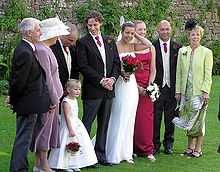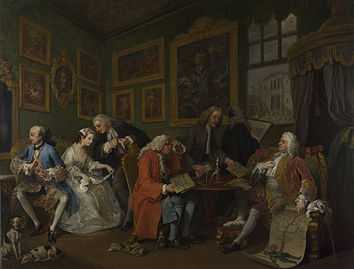Marriage in England and Wales

Marriage, in England and Wales, is legally recognised in the forms of both civil and religious unions, and is open to opposite-sex and same-sex couples. The legal minimum age to enter into a marriage in England and Wales is sixteen years, although this requires parent consent if a participant is under eighteen. There is a distinction between religious marriages, conducted by an authorised religious celebrant, and civil marriages, conducted by a state registrar. Marriage laws in England and Wales have historically evolved separately from marriage laws in other jurisdictions in the United Kingdom.
In 2013, Parliament passed the Marriage (Same Sex Couples) Act, legalising same-sex marriage in England and Wales. Same-sex weddings began on 29 March 2014; however, the provisions of the Act came into force on 13 March 2014, meaning that existing same-sex marriages performed abroad were recognised from that date.[1][2] Prior to this, Civil partnerships had been made available to same-sex couples in the United Kingdom in 2005, granting rights and responsibilities virtually identical to civil marriage.
There are residency conditions that have to be met before people can be married. If one of the people wanting to marry is subject to immigration control, notice of marriage can only be done at a designated register office, which both parties must attend together. Marriage must be between two people neither of whom is in a Civil Partnership or separate marriage (foreign divorces are generally recognised; but an existing foreign marriage would prevent a marriage in the UK as this would be treated as bigamy).
Certain relatives are not allowed to marry. The list of proscribed affinities was reduced in the early twentieth century by the Deceased Wife's Sister's Marriage Act 1907, the Deceased Brother's Widow's Marriage Act 1921 and the Marriage (Prohibited Degrees) Relationship Act 1931.
Marriage procedures

Wedding ceremonies can either be conducted by "authorised celebrants" (usually, but not always, a minister of religion) or by an "authorised Registrar". However, to be legally binding, it must take place with an authorised person or superintendent registrar present (e.g. vicar or priest) and have at least two competent people, who will be required to sign the marriage register as witnesses.[3] Civil marriages may not take place in religious venues, but since the Marriage Act 1994 may take place in other licensed venues. The marriage register is signed by the couple, the celebrant and two witnesses.
Priests of the Church of England and the Church in Wales are legally required to marry people, providing one of them is from the local parish, regardless of whether the couple are practising. Special permission may be granted for out-of-parish weddings.
From the Marriage Act 1753 until 1837, only marriages conducted by the Church of England, Quakers, or under Jewish law, were recognised in England and Wales. This was changed by the Marriage Act 1836 which, in addition to introducing civil marriage, also allowed ministers of other faiths (Nonconformists and Roman Catholics) to act as registrars. The civil marriage law was superseded by the Marriage Act 1949.
The Marriage Duty Acts of 1694 and 1695 required that banns or marriage licences must be obtained. The 1753 Act also laid down rules for where marriages were allowed to take place, whom you were and were not allowed to marry, the requirement for at least two witnesses to be present at the marriage ceremony and set a minimum marriageable age. This led to the practice of couples who could not meet the conditions in England and Wales eloping to Scotland (see Gretna Green#Marriage).
For civil marriages, banns must be posted for fifteen days, at the appropriate register office. Church of England marriages require the banns to be read out three times at the appropriate church or churches unless a Special Licence has been obtained. In most cases, the appropriate churches will be the parish churches where the parties reside and the one where the ceremony is to take place.
A marriage solemnized between persons either of whom is under the age of sixteen is void.[4] This disability is commonly called "nonage".[5]
Parental permission (or, in the event of the prior death of the parents, consent from the legal guardians) is required for either party to a marriage who is less than 18 years old,[6] but as long as they are at least 16 years old, a lack of it does not necessarily invalidate the marriage.[7]
Common law marriage
Legal common-law marriage was, for practical purposes, abolished under the Marriage Act, 1753. The term "common law marriage" is frequently used to describe mere cohabitation, but such a "marriage" is extremely rarely recognised in law; cohabitation does not generally confer any of the rights or obligations associated with marriage on the parties. It survives only in a few highly exceptional circumstances, where people who want to marry are unable to do so any other way and can simply declare that they are taking each other as husband and wife in front of witnesses. British civilians interned by the Japanese during World War II who did so were later deemed to be legally married.
Benefits and consequences
Upon death of one's spouse, bequests to the other spouse do not incur inheritance tax. Intestate property by default will go to the spouse. Also, there is partial inheritance of pensions.
In courts, one spouse may not be compelled to testify against the other. Non-British spouses of British citizens may obtain residence permits if the British spouse meets a minimum income requirement of £18,600 per year. This rises to £22,400 for families with a child, and a further £2,400 for each further child.
Spouses are considered to have a duty of care towards each other, and certain social security benefits are calculated differently from those for single people.
Foreign citizens wishing to marry in the UK
From 1 February 2005, visitors who wish to be married in the UK that are a citizen of a country that is not a member of the European Economic Area (EEA), must apply for a visa before they travel. Without the visa, the registrar will not be able to accept the notice of marriage and will not be able to perform the marriage ceremony.
Until May 2011, persons already in the UK and a citizen of a country that was not a member of the EEA, needed the approval of the Home Secretary to be married. This was provided in the form of a certificate of approval. That programme was discontinued on 9 May 2011.
Royal marriages
Marriages of members of the royal family are regulated by the Royal Marriages Act of 1772, which made it illegal for any member of the British royal family (defined as all descendants of King George II, excluding descendants of princesses who marry into "foreign families") under the age of 25 to marry without the consent of the ruling monarch. Any member of the Royal Family over the age of 25 who has been refused the sovereign's consent may marry one year after giving notice to the Privy Council of their intention to so marry, unless Parliament passes an act against the marriage in the interim. In 2005, the Queen consented formally to the wedding of Charles, Prince of Wales and Camilla Parker Bowles.
The royal family was specifically excluded from the Marriage Act 1836, which instituted civil marriages in England. However, Prince Charles's civil marriage raised questions. Lord Falconer of Thoroton told the House of Lords that the 1836 Act had been repealed by the Marriage Act 1949, which had different wording, and that the British Government were satisfied that it was lawful for the couple to marry by a civil ceremony in accordance with Part III of the 1949 Act, and the Registrar General Len Cook determined that a civil marriage would in fact be valid. Any doubt as to the interpretation of the Marriage Act 1949 was put to rest by the Human Rights Act 1998, which requires that legislation be interpreted in conformity with convention rights wherever possible (including the right to marry, without discrimination).
Divorce
Divorce is allowed on only one ground: the marriage has irretrievably broken down. This must be evidenced in one or more of the five possible facts as stated in the Matrimonial Causes Act 1973:
- Adultery
- Unreasonable behaviour
- Desertion (two years)
- Separation, agreed divorce (two years)
- Separation, contested divorce (five years)
Civil remarriage is allowed. Religions and denominations differ on whether they permit religious remarriage.
See also
- Marriage Certificate
- Civil Partnership
- English Law
- Fleet Marriage
- Melltith, a 200-year-old Welsh marriage custom.
References
- ↑ Department for Culture, Media & Sport, United Kingdom. "First Same Sex weddings to happen from 29 March 2014". HM Government. Retrieved 28 January 2014.
- ↑ http://www.bbc.co.uk/news/uk-26555111
- ↑ http://www.ukcelebrants.co.uk/
- ↑ The Marriage Act 1949, section 2. This replaces section 1 of the Age of Marriage Act 1929.
- ↑ J C Arnold. The Marriage Law of England. Staples Press. 1951. pp 13 & 62.
- ↑ The Marriage Act 1949, section 3
- ↑ The Marriage Act 1949, section 48(1)(b) (applicable to marriage by superintendent registrar's certificate); R v Birmingham (Inhabitants) (1828) 8 B & C 29 (applicable to marriage by common license). As to marriage by publication of banns, see sections 3(3) and 25(c) of the Marriage Act 1949.
| ||||||||||||||